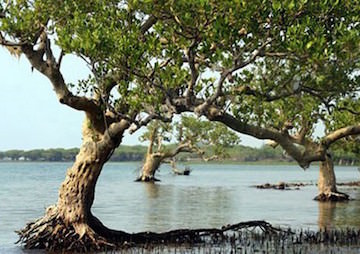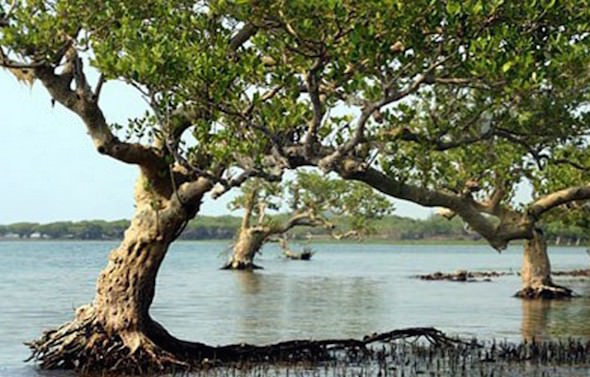Mangroves Face Struggle to Survive Rising Seas
Higher sea levels and less silt will endanger many mangrove forests -- home to huge varieties of wildlife, and natural buffers that protect coasts and estuaries during tropical cyclones -- across the Pacific.
By Tim Radford, Climate News Network

Rising water levels and dwindling silt leave mangroves doubly vulnerable. (Philg88 via Wikimedia Commons)
This Creative Commons-licensed piece first appeared at Climate News Network.
LONDON — In less than one human lifetime, some of the planet’s richest and most vital coastal habitats could disappear. Sea-level rise is expected to flood and drown the mangrove forests of much of the Indo-Pacific.
These subtropical and tropical intertidal forests — home to huge varieties of fish, birds and insects, and natural buffers that protect coasts and estuaries during tropical cyclones — are at risk even if sea level rise is at the bottom of the predicted range, according to Catherine Lovelock, an ecologist at the University of Queensland.
She and colleagues report in Nature that they considered not just rates of sea level rise at a network of 27 sites, but changes in what scientists call “surface elevation” in the mangrove forests of the region: that is, the rate at which estuary silt is being deposited around the mangrove roots.
In the Chao Praya River delta in Thailand, for instance, sediment delivery has been cut by 80% and the coastal mangroves are in retreat.
The scientists found that, in 69% of their examples, the supply of sediment would not keep pace with changes in sea level: that is, by 2070, many forests would be submerged. These would include ecosystems in Thailand, Sumatra, Java, Papua New Guinea and the Solomon Islands.
Adaptation impossible
“Our modelling shows mangroves are likely to persist in east Africa, the Bay of Bengal, eastern Borneo and north-western Australia — areas where there are relatively large tidal ranges and/or higher sediment supply,” Professor Lovelock said.
Although sea levels are projected to rise by a metre or possibly more by the end of the century, under natural conditions the forests could adapt: estuaries would deliver enough mud and silt to enable the mangrove trees to keep, so to speak, their heads above water, and the forests would anyway begin to colonise the higher ground as the tides rose.
But since humans started damming rivers to build hydro-electric plants or to supply cities with water or farmland with irrigation channels, the annual delivery of river silt has steadily fallen.
Many estuaries, and the cities built on them, are subsiding even as tide levels steadily increase because of global warming, thermal expansion (the way that warmer water expands), and the steady melting almost everywhere of glaciers and icecaps to deliver more water to the seas.
Providing protection
By 2100, researchers have calculated, coastal flooding could be costing the world US$100,000 billion a year as a consequence of higher sea levels, higher temperatures and greater extremes of wind and rain, all driven by increasing greenhouse gas emissions from the combustion of fossil fuels.
Mangrove forests, like coral reefs, serve as natural barriers against floods, freak tides and storm surges. The forests also soak up significant quantities of atmospheric carbon and could play an important role in containing climate change. Altogether the Indo-Pacific region is home to most of the world’s mangrove forests. It is also expected to have high rates of sea level rise.
The Nature team believes that city, national and regional authorities should be thinking about conservation, restoration and better management of the forests upstream, and about the rivers that carry the decaying organic material that nourishes the coastal mangrove forests.
“Intertidal mangrove forests occur on tropical and subtropical shorelines, and provide a wide range of ecosystem services — to fisheries, in coastal protection and carbon sequestration — with an estimated value of $194,000 per hectare per year,” Professor Lovelock said.
Your support matters…Independent journalism is under threat and overshadowed by heavily funded mainstream media.
You can help level the playing field. Become a member.
Your tax-deductible contribution keeps us digging beneath the headlines to give you thought-provoking, investigative reporting and analysis that unearths what's really happening- without compromise.
Give today to support our courageous, independent journalists.






You need to be a supporter to comment.
There are currently no responses to this article.
Be the first to respond.